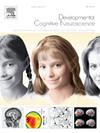Phonological decoding ability is associated with fiber density of the left arcuate fasciculus longitudinally across reading development
IF 4.9
2区 医学
Q1 NEUROSCIENCES
引用次数: 0
Abstract
Numerous studies have linked reading ability to white matter microstructure using diffusion tensor imaging, but findings have been inconsistent and lack specificity. Fiber-specific diffusion-weighted magnetic resonance imaging (dMRI) models offer enhanced precision in measuring specific microstructural features, but they have not yet been applied to examine associations between reading ability and white matter microstructure development as children learn to read. We applied constrained spherical deconvolution (CSD) and fiber-specific modelling to characterize developmental changes in fiber density of key white matter tracts of the reading network, and investigated associations between tract-wise fiber density and children’s phonological decoding abilities. Fiber density was measured from ages 2–13 years, and decoding ability (pseudoword reading) was assessed at ages 6 years and older. Higher decoding ability was associated with greater fiber density in the left arcuate fasciculus, and effects remained consistent over time. Follow-up analysis revealed that asymmetry changes in the arcuate fasciculus were moderated by decoding ability: good decoders showed leftward asymmetry from early childhood onward, while poorer decoders shifted toward leftward asymmetry over time. These results suggest that densely organized fibers in the left arcuate fasciculus serve as a foundation for the development of reading skills from the pre-reading stage through fluent reading.
语音解码能力与纵向阅读发育的左弓状束纤维密度有关
许多研究使用扩散张量成像将阅读能力与白质微观结构联系起来,但研究结果不一致且缺乏特异性。纤维特异性弥散加权磁共振成像(dMRI)模型在测量特定微观结构特征方面提供了更高的精度,但它们尚未被应用于研究儿童学习阅读时阅读能力和白质微观结构发展之间的关系。本研究采用约束球面反褶积(CSD)和纤维特异性模型来表征阅读网络关键白质束纤维密度的发育变化,并研究了神经束纤维密度与儿童语音解码能力之间的关系。从2-13岁开始测量纤维密度,并在6岁及以上评估解码能力(伪词阅读)。较高的解码能力与较高的左弓状束纤维密度有关,并且随着时间的推移,效果保持一致。后续分析显示,弓形神经束的不对称性变化受到解码能力的调节:优秀的解码者从童年早期开始就表现出向左的不对称性,而较差的解码者则随着时间的推移转向向左的不对称性。这些结果表明,左弓状束密集组织的纤维是阅读技能从阅读前阶段发展到流畅阅读的基础。
本文章由计算机程序翻译,如有差异,请以英文原文为准。
求助全文
约1分钟内获得全文
求助全文
来源期刊

Developmental Cognitive Neuroscience
NEUROSCIENCES-
CiteScore
7.60
自引率
10.60%
发文量
124
审稿时长
6-12 weeks
期刊介绍:
The journal publishes theoretical and research papers on cognitive brain development, from infancy through childhood and adolescence and into adulthood. It covers neurocognitive development and neurocognitive processing in both typical and atypical development, including social and affective aspects. Appropriate methodologies for the journal include, but are not limited to, functional neuroimaging (fMRI and MEG), electrophysiology (EEG and ERP), NIRS and transcranial magnetic stimulation, as well as other basic neuroscience approaches using cellular and animal models that directly address cognitive brain development, patient studies, case studies, post-mortem studies and pharmacological studies.
 求助内容:
求助内容: 应助结果提醒方式:
应助结果提醒方式:


